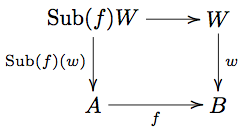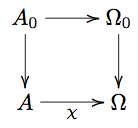Difference between revisions of "User:Michiexile/MATH198/Lecture 10"
Michiexile (talk | contribs) |
Michiexile (talk | contribs) |
||
| Line 42: | Line 42: | ||
We can use the properties of a topos to develop a logic theory - mimicking the development of logic by considering operations on subsets in a given universe: |
We can use the properties of a topos to develop a logic theory - mimicking the development of logic by considering operations on subsets in a given universe: |
||
| − | Classically, in Set, we would say that a ''predicate'' |
+ | Classically, in Set, and predicate logic, we would say that a ''predicate'' is some function from a universe to a set of truth values. So a predicate takes some sort of objects, and returns either True or False. |
| + | |||
| + | Furthermore, we allow the definition of sets using predicates: |
||
| + | :<math>\{x\in U: P(x)\}</math> |
||
| + | |||
| + | Looking back, though, there is no essential difference between this, and defining the predicate as the subset of the universe directly; the predicate-as-function appears, then, as the characteristic function of the subset. And types are added as easily - we specify each variable, each object, to have a set it belongs to. |
||
| + | |||
| + | This way, predicates really are subsets. Type annotations decide which set the predicate lives in. And we have everything set up in a way that open sup for the topos language above. |
||
| + | |||
| + | We'd define, for predicates <math>P, Q</math> acting on the same type: |
||
| + | :<math>\{x\in A : \top\} = A</math> |
||
| + | :<math>\{x\in A : \bottom\} = \emptyset</math> |
||
| + | :<math>\{x : (P \& Q)(x)\} = \{x : P(x)\} \cap \{x : Q(x)\}</math> |
||
| + | :<math>\{x : (P | Q)(x)\} = \{x : P(x)\} \cup \{x : Q(x)\}</math> |
||
| + | :<math>\{x\in A : (\neg P)(x) \} = A \setminus \{x\in A : P(x)\}</math> |
||
| + | :<math>\{x : \exists y. P(x,y) \}</math> is given by the construction (...) |
||
| + | :<math>\{x : \forall y. P(x,y) \}</math> is given by the construction (...) |
||
| + | |||
We could then start to define primitive logic connectives as set operations; the intersection of two sets is the set on which '''both''' the corresponding predicates hold true, so <math>\& = \cap</math>. Similarily, the union of two sets is the set on which either of the corresponding predicates holds true, so <math>| = \cup</math>. The complement of a set, in the universe, is the negation of the predicate, and all other propositional connectives (implication, equivalence, ...) can be built with conjunction (and), disjunction (or) and negation (not). |
We could then start to define primitive logic connectives as set operations; the intersection of two sets is the set on which '''both''' the corresponding predicates hold true, so <math>\& = \cap</math>. Similarily, the union of two sets is the set on which either of the corresponding predicates holds true, so <math>| = \cup</math>. The complement of a set, in the universe, is the negation of the predicate, and all other propositional connectives (implication, equivalence, ...) can be built with conjunction (and), disjunction (or) and negation (not). |
||
Revision as of 21:48, 22 November 2009
IMPORTANT NOTE: THESE NOTES ARE STILL UNDER DEVELOPMENT. PLEASE WAIT UNTIL AFTER THE LECTURE WITH HANDING ANYTHING IN, OR TREATING THE NOTES AS READY TO READ.
This lecture will be shallow, and leave many things undefined, hinted at, and is mostly meant as an appetizer, enticing the audience to go forth and seek out the literature on topos theory for further studies.
Subobject classifier
One very useful property of the category is that the powerset of a given set is still a set; we have an internal concept of object of all subobjects. Certainly, for any category (small enough) , we have a contravariant functor taking an object to the set of all equivalence classes of monomorphisms into that object; with the image given by the pullback diagram
If the functor is representable - meaning that there is some object such that - then the theory surrounding representable functors, connected to the Yoneda lemma - give us a number of good properties.
One of them is that every representable functor has a universal element; a generalization of the kind of universal mapping properties we've seen in definitions over and over again during this course; all the definitions that posit the unique existence of some arrow in some diagram given all other arrows.
Thus, in a category with a representable subobject functor, we can pick a representing object , such that . Furthermore, picking a universal element corresponds to picking a subobject such that for any object and subobject , there is a unique arrow such that there is a pullback diagram
One can prove that is terminal in , and we shall call true. The arrow is called the characteristic arrow of the subobject.
In Set, all this takes on a familiar tone: the subobject classifier is a 2-element set, with a true element distinguished; and a characteristic function of a subset takes on the true value for every element in the subset, and the other (false) value for every element not in the subset.
Defining topoi
Definition A topos is a cartesian closed category with all finite limits and with a subobject classifier.
It is worth noting that this is a far stronger condition than anything we can even hope to fulfill for the category of Haskell types and functions. The functional proogramming relevance will take a back seat in this lecture, in favour of usefulness in logic and set theory replacements.
Properties of topoi
The meat is in the properties we can prove about topoi, and in the things that turn out to be topoi.
Theorem Let be a topos.
- has finite colimits.
Power object
Since a topos is closed, we can take exponentials. Specifically, we can consider . This is an object such that . Hence, we get an internal version of the subobject functor. (pick to be the terminal object to get a sense for how global elements of correspond to subobjects of )
((universal property of power object?))
Internal logic
We can use the properties of a topos to develop a logic theory - mimicking the development of logic by considering operations on subsets in a given universe:
Classically, in Set, and predicate logic, we would say that a predicate is some function from a universe to a set of truth values. So a predicate takes some sort of objects, and returns either True or False.
Furthermore, we allow the definition of sets using predicates:
Looking back, though, there is no essential difference between this, and defining the predicate as the subset of the universe directly; the predicate-as-function appears, then, as the characteristic function of the subset. And types are added as easily - we specify each variable, each object, to have a set it belongs to.
This way, predicates really are subsets. Type annotations decide which set the predicate lives in. And we have everything set up in a way that open sup for the topos language above.
We'd define, for predicates acting on the same type:
- Failed to parse (MathML with SVG or PNG fallback (recommended for modern browsers and accessibility tools): Invalid response ("Math extension cannot connect to Restbase.") from server "https://wikimedia.org/api/rest_v1/":): {\displaystyle \{x\in A : \bottom\} = \emptyset}
- is given by the construction (...)
- is given by the construction (...)
We could then start to define primitive logic connectives as set operations; the intersection of two sets is the set on which both the corresponding predicates hold true, so . Similarily, the union of two sets is the set on which either of the corresponding predicates holds true, so . The complement of a set, in the universe, is the negation of the predicate, and all other propositional connectives (implication, equivalence, ...) can be built with conjunction (and), disjunction (or) and negation (not).
So we can mimic all these in a given topos:
We say that a universe is just an object in a given topos.
A predicate is a subobject of the universe.
Given predicates , we define the conjunction to be the pullback (pushout?)
This mimics, closely, the idea of the conjunction as an intersection.
We further define the disjunction to be the pushout (pullback?)
And we define negation by (...)
We can expand this language further - and introduce predicative connectives.
Now, a statement on the form is usually taken to mean that on all , the predicate holds true. Thus, translating to the operations-on-subsets paradigm, corresponds to the statement .
((double check in Awodey & Barr-Wells!!!!))
So we can define a topoidal by ((diagrams))
And similarily, the statement means that is non-empty.
Examples
Sheaves, topology and time sheaves
Exercises
No homework at this point. However, if you want something to think about, a few questions and exercises:
- blah

